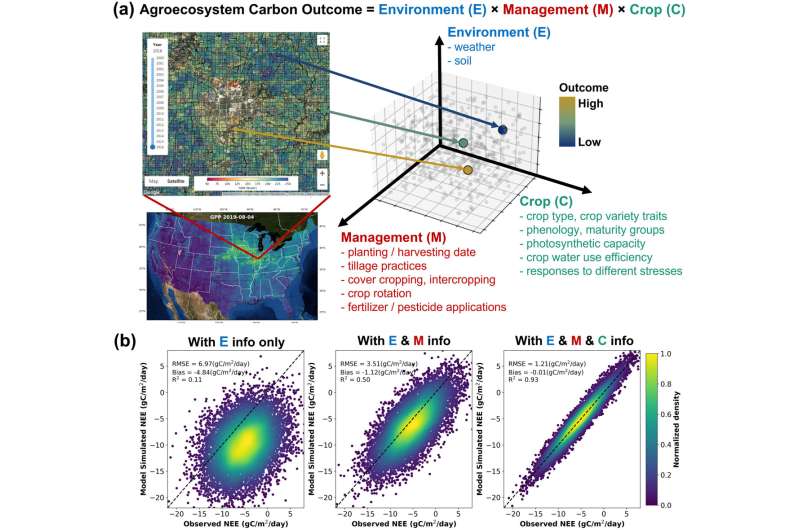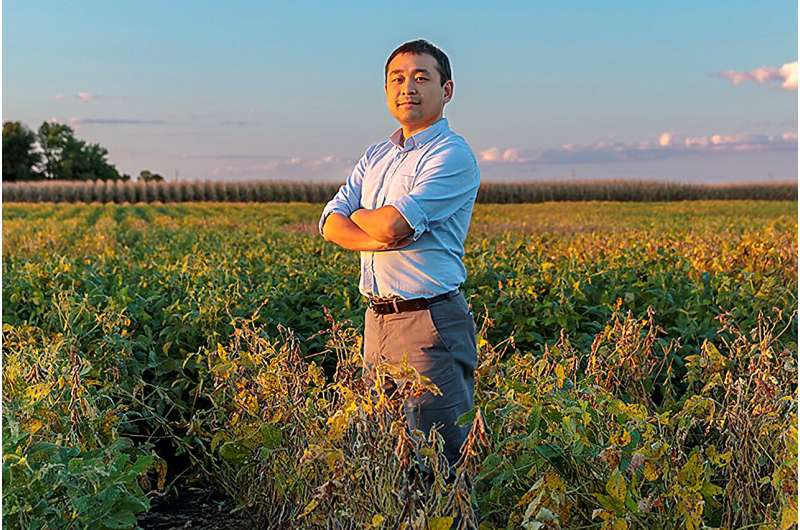This article has been reviewed according to Science X's editorial process and policies. Editors have highlighted the following attributes while ensuring the content's credibility:
fact-checked
peer-reviewed publication
trusted source
proofread
Researchers propose a unified, scalable framework to measure agricultural greenhouse gas emissions

Increased government investment in climate change mitigation is prompting agricultural sectors to find reliable methods for measuring their contribution to climate change. With that in mind, a team led by scientists at the University of Illinois Urbana-Champaign proposed a supercomputing solution to help measure individual farm field-level greenhouse gas emissions.
Although locally tested in the Midwest, the new approach can be scaled up to national and global levels and help the industry grasp the best practices for reducing emissions.
The new study, directed by natural resources and environmental sciences professor Kaiyu Guan, synthesized more than 25 of the group's previous studies to quantify greenhouse gas emissions produced by U.S. farmland. The findings—completed in collaboration with partners from the University of Minnesota, Lawrence Berkeley National Laboratory and Project Drawdown, a climate solutions nonprofit organization—are published in the journal Earth Science Reviews.
"There are many farming practices that can go a long way to reduce greenhouse gas emissions, but the scientific community has struggled to find a consistent method for measuring how well these practices work," Guan said.
Guan's team built a solution based on "agricultural carbon outcomes," which it defines as the related changes in greenhouse gas emissions from farmers adopting climate mitigation practices like cover cropping, precision nitrogen fertilizer management and use of controlled drainage techniques.
"We developed what we call a 'system of systems' solution, which means we integrated a variety of sensing techniques and combined them with advanced ecosystem models," said Bin Peng, co-author of the study and a senior research scientist at the U. of I. Institute for Sustainability, Energy and Environment. "For example, we fuse ground-based imaging with satellite imagery and process that data with algorithms to generate information about crop emissions before and after farmers adopt various mitigation practices."
"Artificial intelligence also plays a critical role in realizing our ambitious goals to quantify every field's carbon emission," said Zhenong Jin, a professor at the University of Minnesota who co-led the study. "Unlike traditional model-data fusion approaches, we used knowledge-guided machine learning, which is a new way to bring together the power of sensing data, domain knowledge and artificial intelligence techniques."
The study also details how emissions and agricultural practices data can be cross-checked against economic, policy and carbon market data to find best-practice and realistic greenhouse gas mitigation solutions locally to globally—especially in economies struggling to farm in an environmentally conscious manner.
To compute the vast amount of information from millions of individual farms, the team is using supercomputing platforms available at the National Center for Supercomputing Applications. "Access to the resources at NCSA allows for this monumental task," Guan said.

"The real beauty of our tool is that it is both very generic and scalable, meaning it can be applied to virtually any agricultural system in any country to obtain reliable emissions data using our targeted procedure and techniques," Peng said.
The challenge of this work will be encouraging widespread adoption of the system, the researchers said.
"Given the U.S. government's $19 billion investment in the Inflation Reduction Act and the upcoming Farm Bill, farmers will be able to adopt more conservation practices," Guan said. "This work will help researchers and policymakers to 'speak the same language' by using this tool that we believe is very valuable in this time of increasing government investment in climate mitigation."
"Bringing more scientific rigor to estimating emissions on farmlands is a huge task. We need credible tools that are simple and practical," said Paul West, a senior scientist at Project Drawdown and a collaborator on this research. "Our research brings a big step closer to meeting the challenge."
More information: Kaiyu Guan et al, A scalable framework for quantifying field-level agricultural carbon outcomes, Earth-Science Reviews (2023). DOI: 10.1016/j.earscirev.2023.104462
Journal information: Earth Science Reviews
Provided by University of Illinois at Urbana-Champaign




















